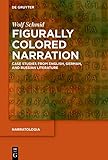Figurally Colored Narration : Case Studies from English, German, and Russian Literature / Wolf Schmid.
Material type: TextSeries: Narratologia : Contributions to Narrative Theory ; 81Publisher: Berlin ; Boston : De Gruyter, [2022]Copyright date: ©2022Description: 1 online resource (XI, 163 p.)Content type:
TextSeries: Narratologia : Contributions to Narrative Theory ; 81Publisher: Berlin ; Boston : De Gruyter, [2022]Copyright date: ©2022Description: 1 online resource (XI, 163 p.)Content type: - 9783110763058
- 9783110763164
- 9783110763102
- 809.923 23/ger
- online - DeGruyter
- Issued also in print.
| Item type | Current library | Call number | URL | Status | Notes | Barcode | |
|---|---|---|---|---|---|---|---|
 eBook
eBook
|
Biblioteca "Angelicum" Pont. Univ. S.Tommaso d'Aquino Nuvola online | online - DeGruyter (Browse shelf(Opens below)) | Online access | Not for loan (Accesso limitato) | Accesso per gli utenti autorizzati / Access for authorized users | (dgr)9783110763102 |
Browsing Biblioteca "Angelicum" Pont. Univ. S.Tommaso d'Aquino shelves, Shelving location: Nuvola online Close shelf browser (Hides shelf browser)

|

|

|

|

|

|

|
||
| online - DeGruyter Kant-Lexikon / | online - DeGruyter Griechische Geschichte ca. 800-322 v. Chr. Band 2, Griechische Geschichte ca. 800-322 v. Chr. ; Band 2: Forschung und Literatur / | online - DeGruyter Dinge zum Sprechen bringen : Performanz der Materialität. Festschrift für Thomas Klie / | online - DeGruyter Figurally Colored Narration : Case Studies from English, German, and Russian Literature / | online - DeGruyter The Social Condition of Deaf People : The Story of a Woman and a Hearing Society / | online - DeGruyter Moonstruck : The Interplay of Celestial Bodies in Pictures / | online - DeGruyter Mondsüchtig : Das Wechselspiel der Gestirne in Bildern / |
Frontmatter -- Preface -- Contents -- 1 Introduction: Narrator and Figure -- 2 Figurally Colored Narration: Terms and Definitions -- 3 Figurally Colored Narration as Text Interference -- 4 Functions and Areas of Application -- 5 Limiting and Uncertain Cases -- 6 Summary and Conclusions -- 7 Works Cited -- 8 Index of Authors and Works
restricted access online access with authorization star
http://purl.org/coar/access_right/c_16ec
Figurally colored narration (FCN) is narrator’s discourse (whether in the first or third person) that adopts salient features of character’s text, mainly valuation and designation, without signaling the figural part in any way. Unlike free indirect discourse, FCN does not refer to current acts of consciousness, but to typical, characteristic segments of the character’s text. There are two main modes of FCN: contagion of the narrator’s discourse with a character’s text, and the more or less ironical reproduction of a character’s text in narrative discourse. In the latter case, the narrator’s criticism may refer to either the content of the character’s text or to its form of expression. This study begins with a definition and an example of FCN as a narrative device, followed by an analysis of terms used for FCN in German, Anglophone and Russian literary criticism. Building on the perception of FCN as a phenomenon of interference between narrator’s and character’s text (text interference), this book analyses the function and applications of FCN in narratives written in German, English and Russian.
Issued also in print.
Mode of access: Internet via World Wide Web.
In English.
Description based on online resource; title from PDF title page (publisher's Web site, viewed 25. Jun 2024)


